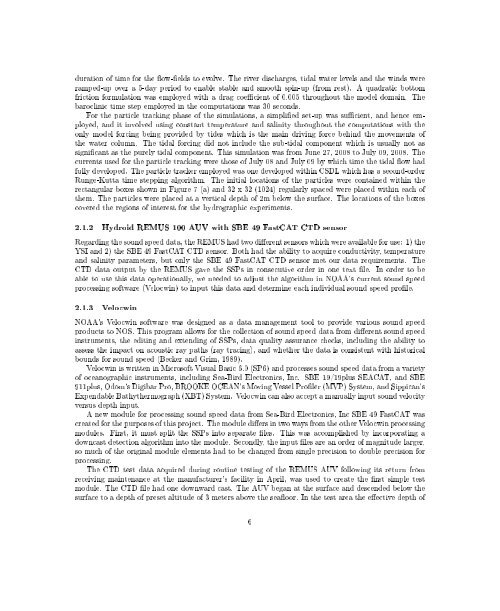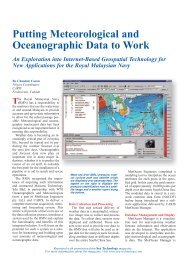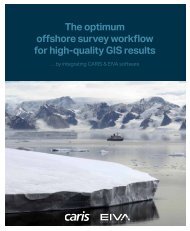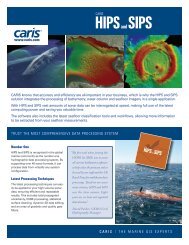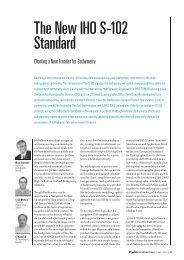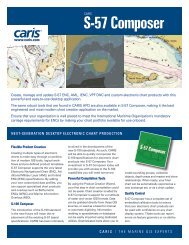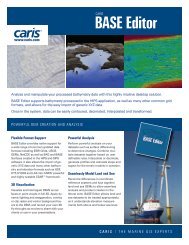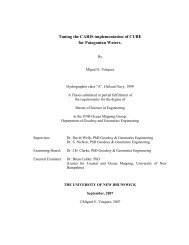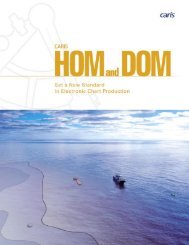Create successful ePaper yourself
Turn your PDF publications into a flip-book with our unique Google optimized e-Paper software.
duration of time for the ow-elds to evolve. The river discharges, tidal water levels and the winds wereramped-up over a 5-day period to enable stable and smooth spin-up (from rest). A quadratic bottomfriction formulation was employed with a drag coecient of 0.005 throughout the model domain. Thebaroclinic time step employed in the computations was 30 seconds.For the particle tracking phase of the simulations, a simplied set-up was sucient, and hence employed,and it involved using constant temperature and salinity throughout the computations with theonly model forcing being provided by tides which is the main driving force behind the movements ofthe water column. The tidal forcing did not include the sub-tidal component which is usually not assignicant as the purely tidal component. This simulation was from June 27, 2008 to July 09, 2008. Thecurrents used for the particle tracking were those of July 08 and July 09 by which time the tidal ow hadfully developed. The particle tracker employed was one developed within CSDL which has a second-orderRunge-Kutta time stepping algorithm. The initial locations of the particles were contained within therectangular boxes shown in Figure 7 (a) and 32 x 32 (1024) regularly spaced were placed within each ofthem. The particles were placed at a vertical depth of 2m below the surface. The locations of the boxescovered the regions of interest for the hydrographic experiments.2.1.2 Hydroid REMUS 100 AUV with SBE 49 FastCAT CTD sensorRegarding the sound speed data, the REMUS had two dierent sensors which were available for use: 1) theYSI and 2) the SBE 49 FastCAT CTD sensor. Both had the ability to acquire conductivity, temperatureand salinity parameters, but only the SBE 49 FastCAT CTD sensor met our data requirements. TheCTD data output by the REMUS gave the SSPs in consecutive order in one text le. In order to beable to use this data operationally, we needed to adjust the algorithm in NOAA's current sound speedprocessing software (Velocwin) to input this data and determine each individual sound speed prole.2.1.3 VelocwinNOAA's Velocwin software was designed as a data management tool to provide various sound speedproducts to NOS. This program allows for the collection of sound speed data from dierent sound speedinstruments, the editing and extending of SSPs, data quality assurance checks, including the ability toassess the impact on acoustic ray paths (ray tracing), and whether the data is consistent with historicalbounds for sound speed (Becker and Grim, 1989).Velocwin is written in Microsoft Visual Basic 6.0 (SP6) and processes sound speed data from a varietyof oceanographic instruments, including Sea-Bird Electronics, Inc. SBE 19/19plus SEACAT, and SBE911plus, Odom's Digibar Pro, BROOKE OCEAN's Moving Vessel Proler (MVP) System, and Sippican'sExpendable Bathythermograph (XBT) System. Velocwin can also accept a manually input sound velocityversus depth input.A new module for processing sound speed data from Sea-Bird Electronics, Inc SBE 49 FastCAT wascreated for the purposes of this project. The module diers in two ways from the other Velocwin processingmodules. First, it must split the SSPs into separate les. This was accomplished by incorporating adowncast detection algorithm into the module. Secondly, the input les are an order of magnitude larger,so much of the original module elements had to be changed from single precision to double precision forprocessing.The CTD test data acquired during routine testing of the REMUS AUV following its return fromreceiving maintenance at the manufacturer's facility in April, was used to create the rst simple testmodule. The CTD le had one downward cast. The AUV began at the surface and descended below thesurface to a depth of preset altitude of 3 meters above the seaoor. In the test area the eective depth of6


